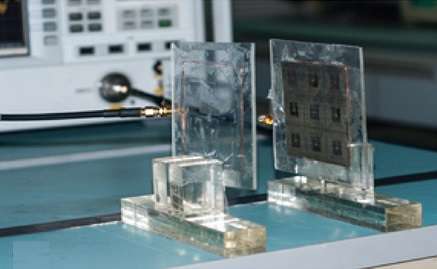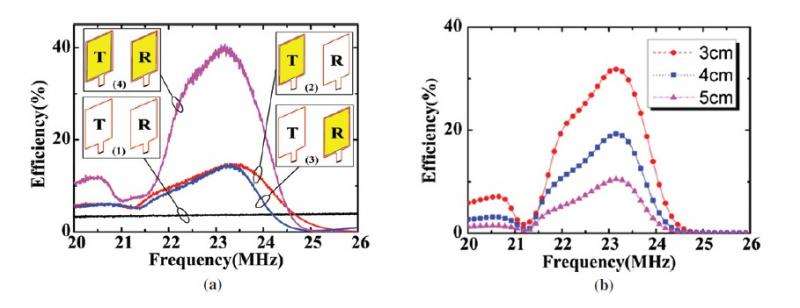April 30, 2015 feature
Wireless power transfer enhanced by metamaterials

(Phys.org)—Over the past decade, research on wireless power transfer has led to the development of several commercial applications, such as wireless charging of mobile devices and electric toothbrushes, as well as wireless powering of radio-frequency identification (RFID) tags. However, these applications are restricted by limitations on the distance and efficiency of current wireless power transfer technology.
In a new study published in EPL, scientists at Tongji University in Shanghai, China, have experimentally demonstrated a way to improve the efficiency of wireless power transfer by using magnetic metamaterials. The new method improves the efficiency of the design from a few percent to nearly 20% at a distance of 4 cm, which could pave the way toward new applications, including wireless charging of implanted pacemakers and electric vehicles.
The concept of wireless power transfer dates back to the 1890s, when Nikola Tesla began experimenting with wireless electricity with limited success. Now more than a century later, the idea has again attracted attention. In 2007, for example, MIT researchers demonstrated wireless power transfer and have been developing products under the start-up "Witricity."
Coincidentally, metamaterials have had a somewhat similar history. Around the turn of the 20th century, scientists began exploring the idea of artificial materials that could manipulate light in unusual ways, but not until the early 2000s were true metamaterials first fabricated.
In the new paper, the Tongji researchers have embedded magnetic metamaterials into the coils used in non-radiative wireless power transfer, which is the method used by most of today's wireless power transfer applications. In the researchers' design, one coil creates a magnetic field, which is captured by the second coil as voltage.

Like all metamaterials, the ones used here contain subwavelength microstructures that can manipulate electromagnetic waves in ways not possible with other materials. Here, the metamaterials are assembled with "meta-atoms," which are 2.6-cm etchings on the spiral copper coils.
This particular size of 2.6 cm is important because it allows for strong coupling between the deep subwavelength resonant modes of the meta-atoms, and this coupling is responsible for increasing the transfer efficiency.
"By embedding metamaterials into non-resonant coils, the overall efficiency of the wireless power transfer system is found to be greatly enhanced, due to the coupling between metamaterials," the researchers wrote in their paper.
Although the efficiency decays quickly as distance increases—from 32% at 3 cm to 15% at 5 cm—the 20% efficiency near 4 cm marks a sweet spot for certain applications, such as wireless charging of pacemakers and other medical devices.
In the future, the researchers hope to build on this metamaterial-enhanced wireless power transfer method to develop many other applications. The scientists expect that, due to the metamaterials' homogenous magnetic behavior, the metamaterials can be assembled like ordinary materials, and so can avoid the technical fabrication challenges that many metamaterials face.
"Since the wireless power transfer system based on metamaterials has many benefits, we believe it can be widely used in medical research, electric vehicle charging, the civilian industry, and so on," the researchers wrote.
More information: Q. Wu, et al. "Wireless power transfer based on magnetic metamaterials consisting of assembled ultrasubwavelength meta-atoms." EPL. DOI: 10.1209/0295-5075/109/68005
Journal information: Europhysics Letters (EPL)
© 2015 Phys.org



















